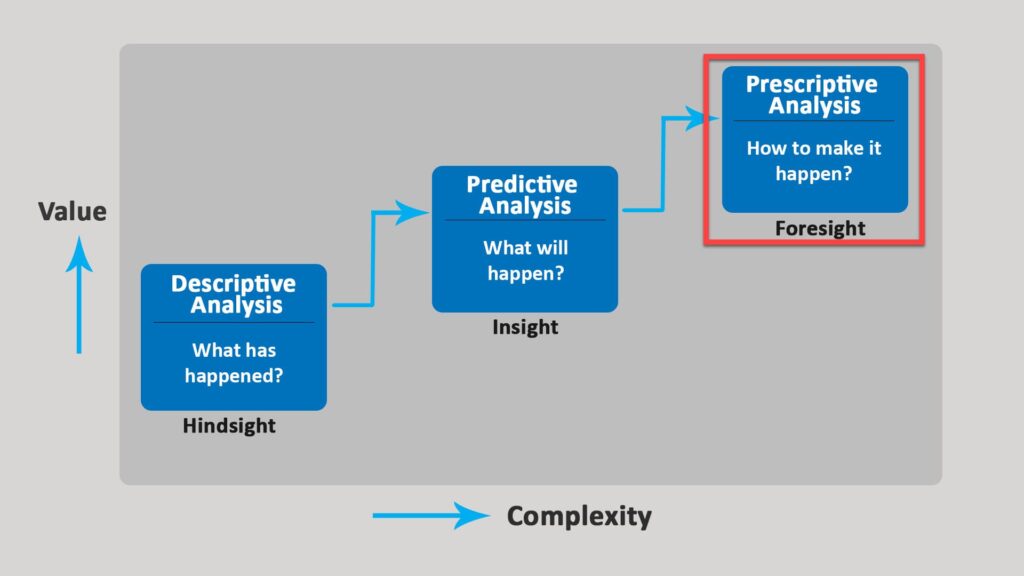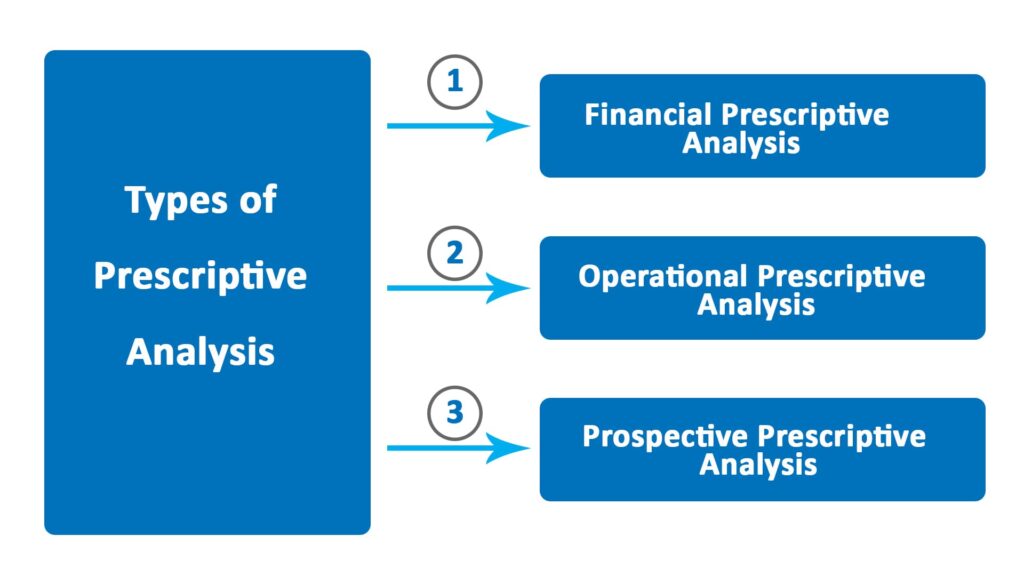Prescriptive analysis is also known as the future of data analytics and is part of business analysis. Businesses have been using it for decades to control potential outcomes after predicting them. These outcomes are molded to help the firm in the long term.
It helps cluster variables together to help achieve the best-suiting results for the business. Most prominent companies like Microsoft and Oracle use prescriptive analysis to optimize processes.
What Is Prescriptive Analysis?

The prescriptive analysis is a data analysis that helps businesses understand what they need to do next. It chooses the best outcome among outcomes that predictive and descriptive analysis provides. Prescriptive analysis is a process of using business data to make recommendations. This improves decision-making processes.
How Does Prescriptive Analysis Work?
The prescriptive analysis uses algorithms to generate recommendations. It gives the business a clear direction about what to do next.
The prescriptive analysis relies on artificial intelligence and uses the power of machine learning. This assists businesses in making statistics-based decisions.
The biggest usage of prescriptive analysis is in finding solutions to business problems. It compares a cohort of solutions to find the ideal one after considering all available factors. The purpose is to see how business processes can be perfected.
Types Of Prescriptive Analysis

1. Financial Prescriptive Analysis
In finance, prescriptive analysis derives strategies necessary to achieve financial goals. It provides the business with a tangible solution to strengthen its financials. The desired outcome is reached through prescriptive analysis in three ways:
- Suggesting methods for streamlining financial events
- Providing actionable insights that improve business trends and outcomes
- Combining datasets to find the best solutions
With prescriptive financial analysis, businesses can run their accounts strategically. It works to find a business’ relevant threats and opportunities. Top management then acts on these recommendations to achieve business goals.
2. Operational Prescriptive Analysis
The operational prescriptive analysis focuses on the business operations. It combines available datasets to find one ideal solution. This solution improves the business’ operational efficiency. It strengthens the operations in the following three ways:
- Helps the business focus on its core work rather than scanning spreadsheets
- Uses informed data to derive ideal processes
- Helps the business gain a competitive advantage through cloud-based prescriptive tools
An operational prescriptive analysis handles minimizing operating errors and maintenance needs. The interconnection improves business functioning when streamlining each process, strategy, and campaign. It leads to minimized costs with impressive business performance.
3. Prospective Prescriptive Analysis
The prospective prescriptive analysis is a combination of two factors:
- An event’s probability to occur
- The outcome’s severity
It helps businesses build a risk matrix. This assists businesses in assessing how risks can affect a particular outcome in the business. Analysts study the data set over a prolonged period to gather all necessary information. The outcome for development is recorded, a decision is made, and action is taken. There are three ways in which prescriptive analysis supports this:
- It decreases the chances of incurring losses through a thorough assessment
- Helps collect complete data and basis decisions on it
- Supplies a long-term solution to businesses
The prospective prescriptive analysis assesses complicated processes with potential risks due to human error. This analysis tries to mitigate losses from these risks. It helps the company save on costs and unnecessary expenditures and improve revenue.
Benefits of Prescriptive Analysis
1. Optimized Operations
Prescriptive analysis optimizes business operations with an optimized plan of action. From pricing to marketing, businesses predict actions delivering an optimal return on investment. It helps businesses remove underperforming business segments. This improves funds utilization and helps gain maximum returns.
2. Increase in Profits
With prescriptive analysis, businesses can increase profits by creating long-term strategies. Analysis removes data inefficiencies and brings teams together. The collaboration determines long-term association, which benefits the company monetarily. Risks are managed efficiently, leading to an increase in profits. It also helps in fraud management by using tools to minimize related loss.
3. Better Decision Making
Prediction is less complicated with prescriptive analysis. This is because it uses past and present data to forecast future outcomes. The outcomes are precise and dependable. This makes strategic decisions valuable and decreases risk changes. This transforms the decision-making process of a company. This seamless decision-making helps the business achieve greater agility that leads to businesses adjusting to the dynamic market quickly.
Quick decisions are made in a cost-effective manner and with an improved process. This helps in increasing business productivity and expertise.
4. Faster Market Response
Since prescriptive analysis is a prediction decision, it predicts upcoming business events. These events help in optimizing business operations. Successful strategic judgments are made based on these predictions.
How a particular event affects the business can be ascertained through this analysis. It also suggests to analysts how to take optimized actions. This leads to a stable financial and economic environment in the firm. Furthermore, it helps businesses respond to the market faster than others. Businesses gain a competitive and comparative advantage over others in the industry.
5. Enhanced Customer Experience
Prescriptive analysis enhances personalized customer experience. This is done by collecting data from several mediums. Then, data analytics helps in obtaining insights. These insights are beneficial for the company. They help the business predict customer behavior. It also tracks customer preferences to provide them with a personalized experience.
Businesses then generate plans in favor of the customs. This enhances customer experience and increases sales. When a business functions according to customer data, its reputation improves in the market.
6. Increases Data Security
Every business is prone to data security and fraud. Prescriptive analysis helps organizations dicker previous data breaches. This helps in detecting the causes of data breaches and avoiding the same. Determining data vulnerabilities help businesses act, so it does not repeat the same mistake. Businesses also derive solutions to safeguard their data both online and offline.
Analysts use prescriptive analytical models to block cyber-attacks. They maintain models to track, analyze and alert the systems.
7. Builds Scalable Processes
Prescriptive analysis helps businesses build scalable processes. These processes grow as the business grows and can also be repeated. When outcomes are accurately predicted, an environment stores the outcome for future use. The dynamic market requires the same solutions for different problems. Historical data interpretation helps businesses build processes and evaluate them in scenarios.
How To Implement Prescriptive Analysis
1. Determine the Problem, Vision, and Scope of the Project
As the first step, identify the problem that the business wants to solve. An analyst can establish a simple problem with more chance of success. The prescriptive analysis will help the analyst understand the issue and derive solutions.
Consequently, determine the project’s vision and scope. This will help the analyst understand whom to involve in the analysis. If it is a large project, analysts can deploy multiple business users for the same. However, if it is a small project, the vision is narrow and fewer people can suffice.
2. Verify Support
Organization support is necessary during prescriptive analysis. This support provides analysts required data. Verify that the business can sponsor concept cases, including engaging with vendors, busting and more.
3. Select the Technology
The next step is to select the right technology to conduct the prescriptive analysis. Determine what model the business needs and the technology to support it. If it is a large-scale analysis, more advanced technologies are preferred. If it is a simpler project, less complex technologies are enough.
4. Set Up an Analytics Team
Setting up a team solely for prescriptive analysis helps in easing the process. Create a team including a project leader, employees, sponsor, and manager. Building this team will ensure all roles and responsibilities are equally divided. This leads to a. seamless analysis process with successful results.
5. Identify Model Requirements
Different data, situations, and models have different requirements. Some events require elaborate data and advanced techniques. On the other hand, some events only require minimal data for analysis. Determining the exact requirements refines the project’s scope. It also helps the data analyst to focus on the core tasks.
6. Build the Model
Building and validating the model marks the commencement of the actual analysis process. The analyst must support it with relevant data while creating a model that is representative of the problem. Accurate outcome representation is critical to validating the model’s results. This ensures output after feeding inputs is dependable and usable.
7. Collect Data
Collect data once the analyst has figured out the model and technique requirements. Identify all data that one needs to use in the model. This is the foundation of the analysis, so analysts must ensure that they collect relevant and reliable data. Data that is both relevant and accurate will provide better results.
8. Extract and Prepare Data
Extracting and preparing data refers to finally using the data in the analysis. Analysts set up interfaces to enter data, run models and identify results. After preparing the data, it is extracted onto these interfaces. Then, analysts can find solutions to the problem.
9. Test the Model
The analyst can evaluate the model after feeding data into it. Analysis techniques like game theory, data management algorithms, graph databases, and more can be used. This helps in simplifying the data and interpreting results. When the results are close to accurate, the model testing is successful. The entire process must be repeated if the model fails to prove results.
10. Implement the Analysis
Lastly, after assessing the model, implement it in the business. The results, data, and solutions are rolled out in the business. This helps in identifying business loopholes and makes operations more efficient.
Example Of Prescriptive Analysis
Suppose Mr. X is a data analyst in ABC Ltd., a manufacturing company. The company has been facing a drop in its sales since the last fiscal year. The company asks Mr. X to conduct a prescriptive analysis to find the issue.
Mr. X decides to consider the past performance of the company, the current situation, and financial statements. He does so because he believes the sales drop is due to an external factor. The company needs a solid long-term strategy to accelerate its sales again and maintain its profitability.
After gathering the required data, Mr. X feeds the data into the prescriptive analysis model. The model provides him with solutions to the problem: a drop in company sales. The data analysis tells Mr. X that the drop in sales has occurred due to the entry of 5 new competitors in the market for the same product.
Out of all the solutions, Mr. X believes that employing a price discrimination strategy is ideal. He suggests that using this strategy will help the company increase sales. It will also boost long-term profits and revenue. Hence, prescriptive analysis helps the business identify the root cause of an essential issue.
Conclusion
Prescriptive analysis helps the data analyst choose the ideal outcome from a pool of outcomes. The final chosen outcome benefits the longevity of the business. Overall, analysts can assess the necessary data variables needed to achieve results benefiting the company.
